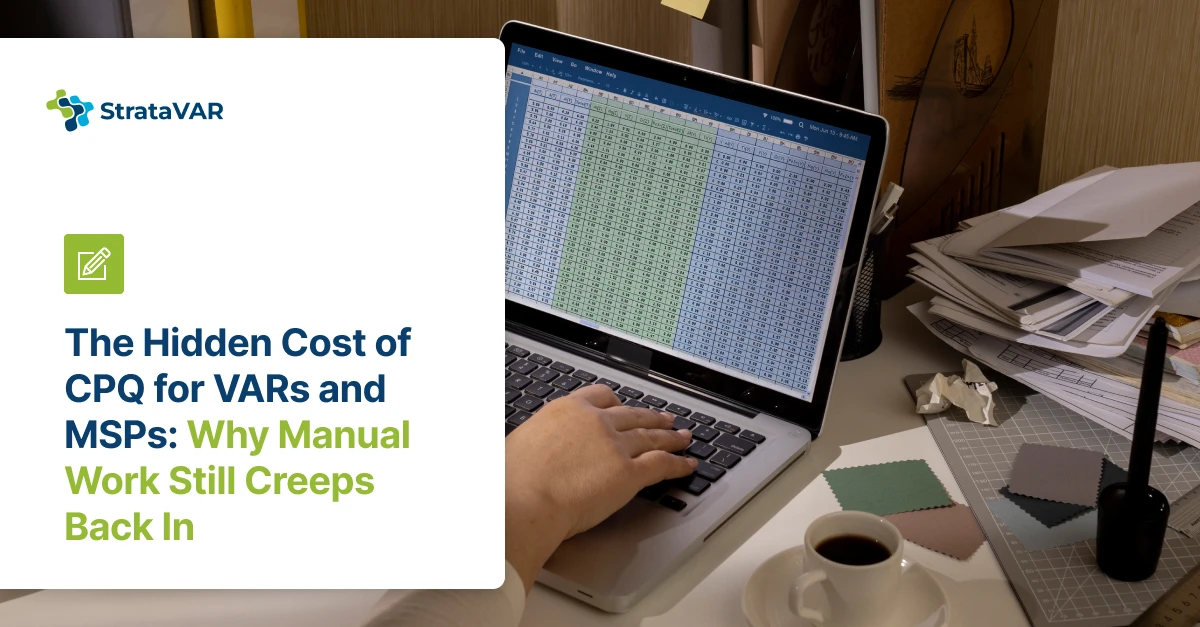Maximizing Revenue: Avoiding Costly Mistakes in VAR’s Mismanagement of Vendor Incentive Programs

This is a div block with a Webflow interaction that will be triggered when the heading is in the view.
This is a div block with a Webflow interaction that will be triggered when the heading is in the view.
In the intricate landscape of Value Added Resellers (VARs) and System Integrators, the effective management of Vendor Incentive Programs (VIPs) can make the difference between success and missed opportunities.
These programs foster better vendor engagement, actively promoting products or services. VIP Management also encourages faster market responses, strengthening relationships with key partners as incentivized vendors are more likely to respond quickly to market changes and adapt their strategies accordingly. Maximizing the VIP for the VARs can help them stay ahead of the competition and take advantage of emerging trends and customer preferences, driving innovation. Ultimately, effective VIP management leads to improved customer satisfaction and retention. By incentivizing vendors, businesses can seize opportunities that might otherwise be missed, stay ahead of market changes, and create a collaborative environment conducive to mutual growth and success.
However, it’s surprising to note that a substantial number of companies overlook or mismanage this crucial aspect of their operations, resulting in costly mistakes in VAR’s. VIP management requires intricate rebate plans that are designed to incentivize the sale of specific, high-value equipment. Navigating this complex landscape of VIP management, necessitates the implementation of sophisticated algorithms and stringent adherence to the requirements and rules that govern the application of rebates to specific VARs and deals. Effectively leveraging these VIPs, with the end goal of maximizing the VIP for the VARs, entails meticulous calculations and an ongoing evaluation of alternative deals that can be facilitated through different VIPs, amplifying the complexity of the process.
In this blog, we’ll explore some of the costly mistakes in VAR’s, the pitfalls that VARs often encounter in the realm of VIP management and how these mistakes can hinder potential revenue growth and optimization.
Costly Mistakes in VARs #1: Underestimating the Power of VIPs
Many VARs underestimate the potential value of VIPs, treating them as an afterthought rather than an essential tool for amplifying their profit margins. By ignoring the intricate details and potential benefits of maximizing the VIP for VARs, businesses inadvertently leave money on the table. This is often a result of VARs selling solutions and hardware they are familiar with rather than advanced solutions that are more suitable to the end user and can maximize the VIP for the VARs.
Costly Mistakes in VARs #2: Overlooking Competitive Advantage
Some companies fail to recognize the importance of VIP management and competitive advantage that can be gained by leveraging VIPs effectively. By not passing the benefits of these programs to end-users through competitive pricing strategies, VARs miss out on opportunities to outshine competitors in the market, and maximize the VIP for the VARs.
Costly Mistakes in VARs #3: Neglecting Collaboration in Solution Design
The lack of collaboration between the sales team and the sales engineers often leads to incomplete utilization of VIPs in the solution design process. Overlooking VIP management and the potential impact of VIPs during the initial phases of solution design can lead to missed opportunities for more lucrative deals. Furthermore, incorporating VIPs considerations during the closing phases of a transaction may result in redundant iterations, necessitating repeated recalculations and potentially overwhelming sales teams.
Costly Mistakes in VARs #4: Inadequate Auditing Mechanisms
Without robust auditing tools, VARs struggle to accurately assess the benefits they are entitled to from VIPs and to miss out on maximizing the VIP for the VARs. The absence of an independent mechanism to track and evaluate the VIPs they are owed can lead to missed revenue opportunities, as these are pure profits that directly contribute to the bottom line, and the inability to rectify inaccuracies in recorded transactions.
Costly Mistakes in VARs #5: Ownership Confusion within Enterprises
The confusion regarding the ownership of VIPs within enterprises further complicates matters. With various departments, including finance and operations, having stakes in maximizing VIP benefits, the absence of clear ownership can lead to a lack of coordinated efforts and a failure to harness the full potential of these programs.
Costly Mistakes in VARs #6: Periodical performance assessment of VIP
Vendors typically structure their incentive programs to assess the performance of their partners over specific periods, usually aligning with their own financial reporting cycles. Also, another important consideration in VIP management, VIP is normally lost if it is not claimed before or by the end of the vendor’s financial year end. However, this approach can place substantial pressure on the VAR teams tasked with meeting VIP requirements and their efforts in maximizing the VIPs for VARs. As the quarter draws to a close, the urgency to secure rebates can shift representatives’ focus from their primary goal of closing deals to VIP management and securing VIP rebates, diverting their attention from the core sales process, potentially impacting deal closures and revenue generation.
To overcome these common mistakes, VARs must implement a strategic approach to VIP management from early stages of the sales process. This includes:
- Creating awareness among the sales team about the potential benefits of maximizing the VIPs for VARs and incentivizing them accordingly.
- Facilitating collaboration between sales engineers and the sales team to ensure that VIPs are considered in the solution design process.
- Implementing robust auditing mechanisms to accurately track and evaluate the benefits owed from VIPs as part of their VIP management.
- Establishing clear ownership within the enterprise and fostering collaborative efforts between departments to maximize the VIP for VAR’s and additional benefits of these programs.
By acknowledging these critical mistakes and implementing proactive strategies, VARs can optimize their revenue streams and unlock the full potential of Vendor Incentive Programs. Embracing these practices is pivotal in today’s fiercely competitive market, where even the smallest oversight can lead to substantial revenue losses.

.webp)

